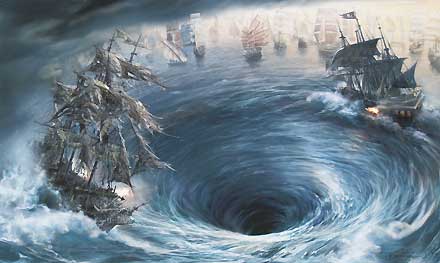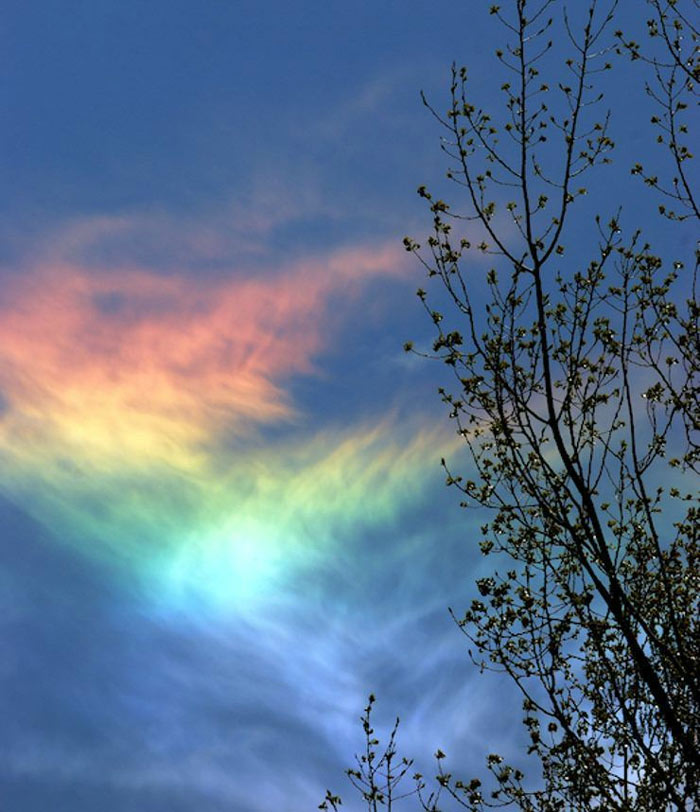There are natural phenomena you do not know, because they rarely happen or because you are in a geographic location without abnormalities. These phenomena are either very strange, or very splendid, but once witnessed, they can leave us with strong impressions, forever not forgetting.
Natural phenomena are rarely surprising
Try to see if you know about these phenomena:
1. Torn water

Water whirlwind is a phenomenon of a very large and extremely powerful vortex on the surface of the water, capable of attracting anything falling into its control and sinking to the bottom of the water. The first described cyclone is in Moskstraumen (Netherlands), caused by two very strong currents. That seabed is the intersection of two groundwater currents representing those two ocean currents.

2. Rainbow fire

The term 'rainbow fire' can be misleading. In essence it is an arc around the horizon (circumhorizon arc). It is mainly ice halo, because ice crystals are in very high clouds in the sky. The spectacle of this color performance is not uncommon, often seen near the latitude in summer, but rarely appears in Central or Northern Europe.

Of course, it does not form like the usual rainbows we see. Light passes through the hexagonal ice crystals vertically and passes through the nearest horizontal bottom. When rearranging in a straight line, it makes the whole cloud shine into rainbow colors.
3. Fire hose

A water cannon is a circular whirlpool of water that rises from below the surface of the water, connecting each block to a tiered cloud.

Usually they are weaker than the whirlwinds on the ground, but there are also much more powerful cannons and swept the water to the sky with very high speed and tremendous power.

They may be tornadoes or not tornadoes. When not a tornado, they are weaker and not as dangerous because the wind speed is below 30 m / sec. In the type of tornado, the whirlwind is the 'core' of the water cannon. The volume of water is entangled with a huge water cannon and if you have witnessed it once, it is unforgettable.

The 'cousin' of a water cannon is ' snowspout ' or 'ice spout' (icespout). 'Snow hoses' form when a whirlwind occurs during a snowfall. It is so rare that only six pictures of it have been taken since ancient times.
4. Fish rain in Honduras
This phenomenon is extraordinary. Yet it has been more than a century since it rained fish once a year.

Every year, in the middle of May and July, a dark cloud appears in the sky, followed by lightning and heavy rain lasting 2-3 hours. At the end of the rain, going to the street, people caught hundreds of fish that were still alive, a row of land on the ground, of course becoming a proud dish of lucky people.

Unable to explain the reason, everyone thought that strong winds and whirlwinds brought the fish to the sky, traveling up to 200 km. All are not marine fish, but freshwater fish. National Geographic magazine sent a delegation to survey. They found it was not a fish in the area, and all were blind, so it was hypothesized that these fish lived in some underground river that had not yet been discovered. Come to Honduras in the summer, maybe you are not lucky to catch one.
5. Rainbow moon

You probably saw the rainbow many times after the rain, did you meet the rainbow at night? Rare but yes. It is called "moon moon" (English called moonbow, lunar rainbow or white rainbow). Of course the light emitted by the Moon is weaker than the sunlight, so the eyes often do not see the color (or very faint), making the rainbow moon only a halo of white moon.

The biggest opportunity for you to admire the moon moon is on the full moon night or 16 lunar calendar when the moon shines most, the sky is cloudless and rain falls right in front of the moon.

6. Ice pad

Crystallized ice into a sharp block that grows together makes a giant ice sheet, only seen at high latitudes. The height of glaciers varies from a few centimeters to 2 meters or more. The shimmering, white icefield has made researchers study passionately since Darwin. This great naturalist saw for the first time and described them.

The mechanism of rock formation is quite complicated, due to many factors: the melting process of ice in this place, sublimation in that place makes the ice surface uneven. The wind accelerates the difference, making the ice surface become more and more convex. The reflected solar radiation on the convex surface is not uniform, which contributes to the difference to the polar belt, which makes it a deep bottom, where it is a sharp peak, and gradually forming ice sheets.
7. Super drive (Supercell)

Super thunderstorms are air currents - the rotating water sucks up from the bottom in a great thunderstorm. They can appear anywhere in the world, lasting 2-3 hours, sometimes divided into two, into two storms with opposite directions.

Super thunderstorms often produce hail, or very heavy showers, very strong winds and when facing down, they follow large ice cubes.

8. Round ice sheets

The phenomenon of circular ice floats floating on the water rarely occurs, only in very slow flowing waters and cold climates like in Northern Europe and the United States.
There are two types of ice sheets, depending on the forming conditions.

The first type is formed in the condition that it is not raining, the temperature is below 0 o C for many days in the river bends. Due to the impact of moving forces, it caused the edge of the iceberg to be broken, then eroded for a long time, becoming perfect circles.

The second type looks even more beautiful. There are also ice-shaped ice sheets, formed in the middle of the river. Sometimes there is water in the middle of a large round ice, which looks like a floating pond in the river.
 'Fine laughs' - Scary and painful torture in ancient times
'Fine laughs' - Scary and painful torture in ancient times The sequence of numbers 142857 of the Egyptian pyramids is known as the strangest number in the world - Why?
The sequence of numbers 142857 of the Egyptian pyramids is known as the strangest number in the world - Why? History of the iron
History of the iron What is alum?
What is alum?